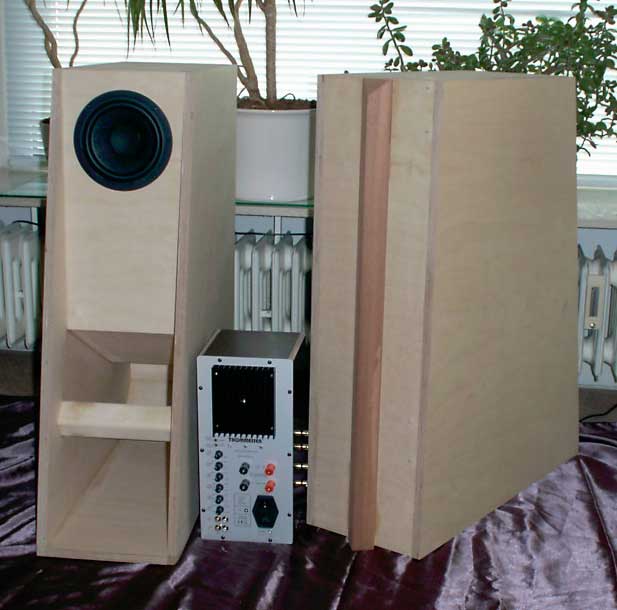hello - i was curious, when i design horns should i design them for use outdoors or indoors? Whenever i select 2 pi radians for free standing as in a field or soemthing, they require housings in excess of 20 cubic feet, which is out of the question. My goal is to have a few medium sized 15" horns or lots of little 12" horns, but for some reason i cant design soemthing that stacks on deep lows in medium to large groups. Am i doing something wrong?
Horn and LF = big. Physics.
I design for where I'm going to use them, but always use 2pi as a reference point as gyprock/stud walls aren't very rigid, so I may not get the gains from imaging or room gain the program calculates.
Have you looked at the Collaborative Tapped Horn thread? Lots of great ideas and (potential) designs there, many with Hornresp data to give you something to work from.
Mine will be using the LAB12 drivers I have on hand. They are big, but the footprint is small and they'll integrate into the room aesthetically far better than my LABhorns ever did.
I design for where I'm going to use them, but always use 2pi as a reference point as gyprock/stud walls aren't very rigid, so I may not get the gains from imaging or room gain the program calculates.
Have you looked at the Collaborative Tapped Horn thread? Lots of great ideas and (potential) designs there, many with Hornresp data to give you something to work from.
Mine will be using the LAB12 drivers I have on hand. They are big, but the footprint is small and they'll integrate into the room aesthetically far better than my LABhorns ever did.
calculation
Hello,
it is more or less simple:
sorrry in german:
Berechnung von Expo Hörnern
Wenn man AH, AM, l, hat
fehlt noch k das Öffnungsmaß:
ln (AM/AH)/l = k
damit kannst du die Fläche an
jeden Punkt ausrechnen (Al):
INV ln (l*k)*AH=Al
l in m, AH+AM in qm, Al in qm
Al durch z.B. die Breite in m teilen und
du hast den Abstand in m.
AH = Hornhals, Horn throat
AM = Hornmund, horn mouth
k = Trichterkonstante, flare rate
l = Länge, length
Längen und Trichterkonstanten WERTE
K WERTE:
0,37 ~ 10 Hz
0,55 ~ 15 Hz
0,7 ~ 19 Hz
0,9 ~ 25 Hz
1,1 ~ 30 Hz
1,3 ~ 35 Hz
1,48 ~ 40 Hz
Etwa eine Oktave über k spielt das Horn,
wenn die Länge dazu passt. Bei BL Hornlängen
über ca. 3,4 m sinkt der
erste Kammfiltereffekt in den Übertragungsbereich.
unter 100 Hz.
Längen WERTE 4/lamda
3,4 m ~ 25 Hz
2,8 m ~ 30 Hz
2,4 m ~ 35 Hz
2,1 m ~ 40 Hz
1,7 m ~ 50 Hz
1,4 m ~ 60 Hz

small is beautiful
Hello,
it is more or less simple:
sorrry in german:
Berechnung von Expo Hörnern
Wenn man AH, AM, l, hat
fehlt noch k das Öffnungsmaß:
ln (AM/AH)/l = k
damit kannst du die Fläche an
jeden Punkt ausrechnen (Al):
INV ln (l*k)*AH=Al
l in m, AH+AM in qm, Al in qm
Al durch z.B. die Breite in m teilen und
du hast den Abstand in m.
AH = Hornhals, Horn throat
AM = Hornmund, horn mouth
k = Trichterkonstante, flare rate
l = Länge, length
Längen und Trichterkonstanten WERTE
K WERTE:
0,37 ~ 10 Hz
0,55 ~ 15 Hz
0,7 ~ 19 Hz
0,9 ~ 25 Hz
1,1 ~ 30 Hz
1,3 ~ 35 Hz
1,48 ~ 40 Hz
Etwa eine Oktave über k spielt das Horn,
wenn die Länge dazu passt. Bei BL Hornlängen
über ca. 3,4 m sinkt der
erste Kammfiltereffekt in den Übertragungsbereich.
unter 100 Hz.
Längen WERTE 4/lamda
3,4 m ~ 25 Hz
2,8 m ~ 30 Hz
2,4 m ~ 35 Hz
2,1 m ~ 40 Hz
1,7 m ~ 50 Hz
1,4 m ~ 60 Hz

small is beautiful
Robotnation,
Basic requirements for a horn include
length =1/4 wavelength of cutoff freq
mouth circumference=1 wavelength
For example,wavelength at 20 hz=56.5 feet,so horn length should be 14.125 ft.
Dividing 56.5 by pi gives 17.98 ft for the dia of the horn mouth.Area would then be 254 sq ft.
Since it will be used inside,you can divide by eight,(corner loaded) so you will only need 32 sq ft.(!)
As you can see,low freq horns are huge.
The good news is that you can make them somewhat smaller,and still get acceptable performance.It's just a matter of how much compromise you are willing to make.Room size,SWIMBO,etc...
A LABhorn,for example,(26 cu ft) does well down to 30 hz when corner loaded.
Here is a link to some basic horn theory that explains it much better than can be done in a short post.
http://melhuish.org/audio/horn.html
Basic requirements for a horn include
length =1/4 wavelength of cutoff freq
mouth circumference=1 wavelength
For example,wavelength at 20 hz=56.5 feet,so horn length should be 14.125 ft.
Dividing 56.5 by pi gives 17.98 ft for the dia of the horn mouth.Area would then be 254 sq ft.
Since it will be used inside,you can divide by eight,(corner loaded) so you will only need 32 sq ft.(!)
As you can see,low freq horns are huge.
The good news is that you can make them somewhat smaller,and still get acceptable performance.It's just a matter of how much compromise you are willing to make.Room size,SWIMBO,etc...
A LABhorn,for example,(26 cu ft) does well down to 30 hz when corner loaded.
Here is a link to some basic horn theory that explains it much better than can be done in a short post.
http://melhuish.org/audio/horn.html
- Status
- This old topic is closed. If you want to reopen this topic, contact a moderator using the "Report Post" button.